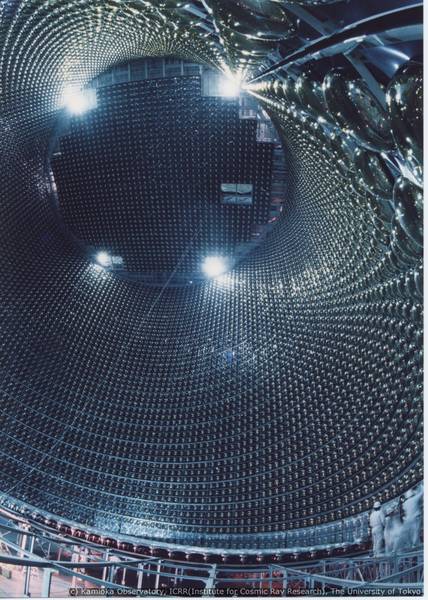06.10.2015
Nobelprize in Physics: Congratulation to the Laureates
The Excellence Cluster Universe congratulates this year's Nobel laureates in physics, Takaaki Kajita and Arthur B. McDonald. The two scientists are the principle investigators of two large experiments, Super-Kamiokande in Japan and Sudbury Neutrino Observatory in Canada, that for the first time were able to show that neutrinos have mass. But there are further puzzles concealed by neutrinos that are of great importance for particle physics.
"We congratulate Takaaki Kajita and Arthur B. McDonald cordially on this special award," says Stefan Schönert, professor for experimental astroparticle physics at the TU München and a member of the Excellence Cluster Universe. "This year's Nobel Prize in Physics honours a fundamental discovery in the field of particle physics that enlightened a long unsolved neutrino problem." The mystery began in the 1960s, when physicist started to theoretically calculate the number of neutrinos produced in the sun. However, various measurements on earth showed that up to two-thirds of the calculated amount were missing. But where did the neutrinos go?
According to the Standard Model of particle there are three types of neutrinos: electron, muon and tau neutrinos. Each neutrino has a charged partner, the electron, and the two much heavier and short-lived partners, the muon and the tauon. The sun only produces electron neutrinos. Could they have been transformed to muon- and tau-neutrinos on their way to earth?
This hypothesis was extremely difficult to verify and only by means of giant detectors. The Super-Kamiokande experiment, initiated by the late Yoji Totsuka, started its operation in 1996 in a zinc mine near Tokyo around 1,000 meters below ground. The detector was filled with 50,000 tons of water and caught muon-neutrinos coming straight from the atmosphere above, as well as those hitting the detector from below after having travelled through the entire globe.
There ought to be equal numbers of neutrinos coming from the two directions, since the earth does not constitute any considerable obstacle to them. But the muon-neutrinos that came straight down to Super-Kamiokande were more numerous than those first passing through the earth. This indicated that muon-neutrinos that had travelled through the globe had time to undergo an identity change, which was not the case for the muon-neutrinos that came straight from above. As the number of electron-neutrinos arriving from different direction were in agreement with expectations, the muon-neutrinos must have switched into the third type, the tau-neutrinos. However, their passage could not be observed in the detector.
Within the Super-Kamiokande collaboration, Takaaki Kajita was the co-convener of the atmospheric neutrinos and proton decay group, and he also played a pivotal role in discovering the atmospheric neutrino anomaly in the previous generation experiment Kamiokande.
The missing puzzle fell in place with the Sudbury Neutrino Observatory (SNO) in Ontario, Canada, which had been designed for the measurement of solar neutrinos. The detector was filled with 1,000 tons of heavy water and was launched in 1999 with Arthur B. MacDonald as director. But the experiment only observed one third of the expected electron-neutrinos, two-thirds had disappeared. The sum, however, if counting all three types together, correspond to the expected number of neutrinos. The conclusion was that the electron-neutrinos must have changed identities on the way. "Such a transformation, however, is only possible if neutrinos are massless," says Prof. Stefan Schönert.
The discovery that neutrinos have mass is of ground-breaking consequence for particle physics: "According to the Standard Model that so far had perfectly accounted for all particle properties, neutrinos don’t have mass", explains Stefan Schönert. "Thus, the results of Kajita and McDonalds have revealed an apparent crack in the standard model." Several key questions about the nature of the neutrinos need to be answered: What are the neutrinos' masses? Why are they so leightweight? Are there more than the three types of neutrinos known so far? Are neutrinos their own antiparticles? Why are neutrinos so different from other elementary particles? "These are important questions, and a solution is of fundamental importance for particle physics," says Stefan Schönert.
Further information:
www.e15.ph.tum.de
Experiment Borexino
Experiment Gerda
Faszination Forschung 16: Signals from deep inside the sun
In the media:
Geisterjäger im tiefen Fels
Entdecker der Neutrino-Masse ausgezeichnet
Contact:
Prof. Stefan Schönert
Technische Universität München
James-Franck-Str. 1
85748 Garching
Germany
Tel.: + 49 89 289-12511
E-Mail: schoenert@ph.tum.de
Prof. Lothar Oberauer
Technische Universität München
James-Franck-Str. 1
85748 Garching
Germany
Tel.: + 49 89 289-12509
E-Mail: lothar.oberauer@ph.tum.de






